This post was first written in June 2013 and updated in June 2021.
Scones ( how do you pronounce that where you are?) have been cooked and eaten in the UK since at least 1513. In the UK, we like a light and fluffy scone, and to enjoy it still warm from the oven, with butter or cream, and jam, most often strawberry jam.
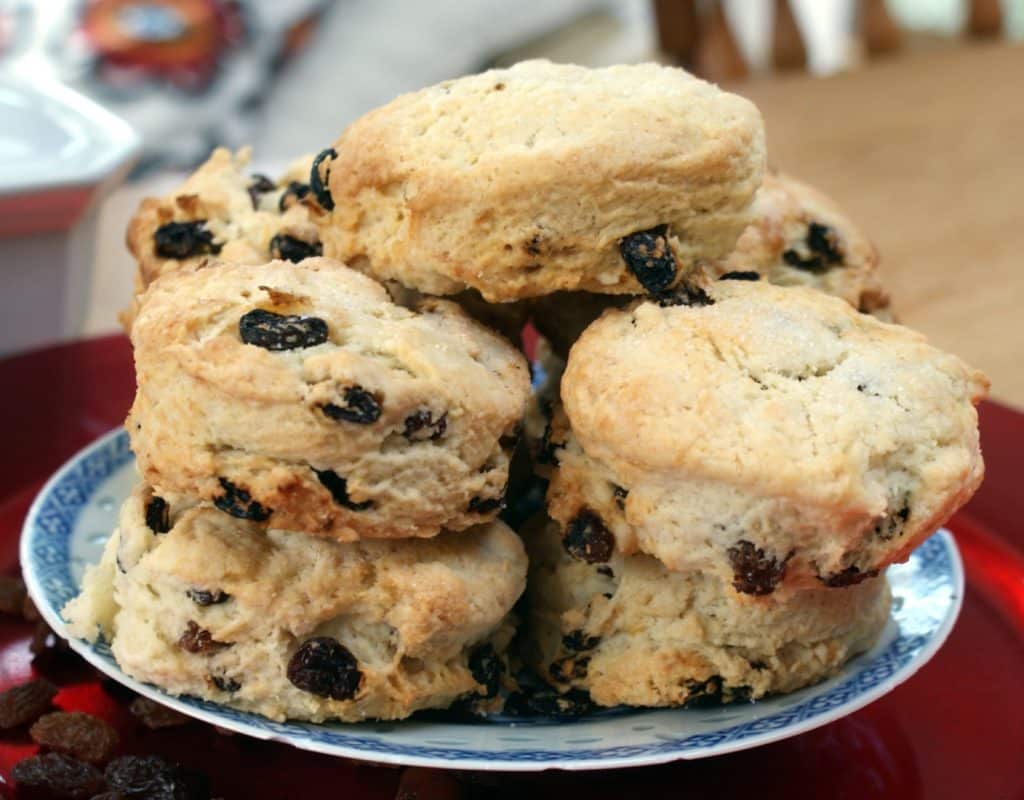
There is much debate on which goes on first, the cream or the jam. If you are in Cornwall, the tradition is to spread the jam on each half of a split scone, then add clotted cream. In Devon, the cream must go on first, then the jam on top. Personally, I don’t mind which way round they go on, either way, a fresh scone with jam and cream is heaven!
Cheese scones are nearly as popular as plain or fruit ones for adorning with cream and jam. The cheese ones usually come with butter to spread on.
We used to have scones fairly often to fill our ever hungry tummies when I was growing up. Mum made lovely ones and if she used milk that had gone sour, they were extra light. For that reason, I sometimes use yogurt to make mine, that has the same effect. These particular ones have neither eggs nor milk as none is available on the Meal Plan, making these vegan fruit scones. Nevertheless, they are still light and delicious.
I’ve added various things to scones over the years, my most recent invention being chocolate ones, which were very successful. Super delicious spread with hazelnut and chocolate spread!
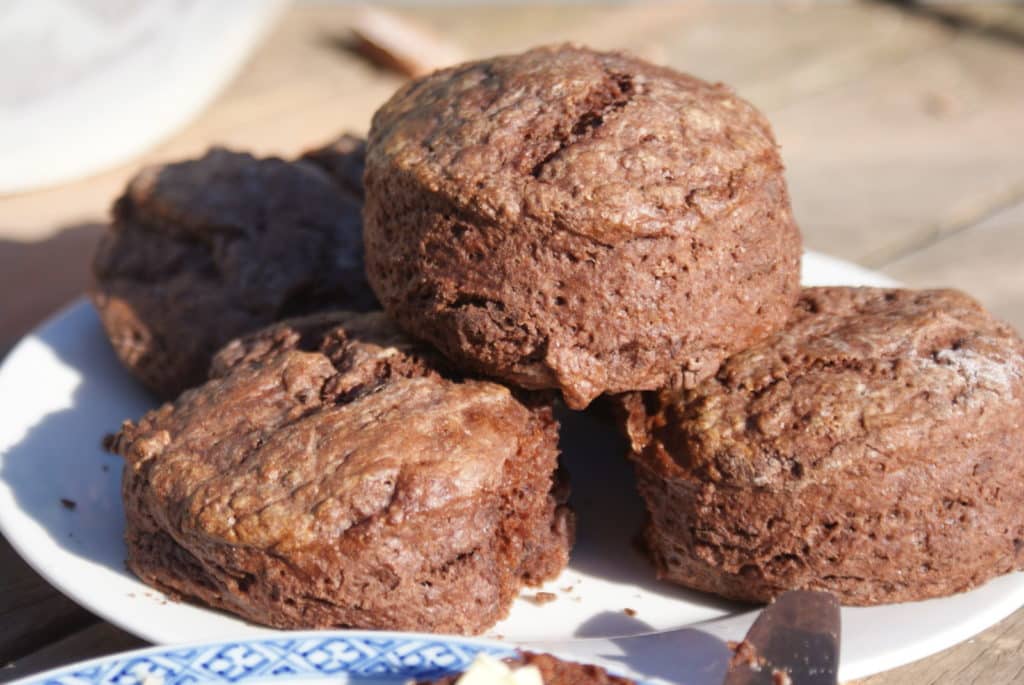
If you are following Meal Plan 1, Meal Plan 2, Meal Plan 3, Meal Plan 7 or Meal Plan 8, make these fruit scones once during the week, and eat them any time you want them. Any that aren’t eaten on the day of baking will keep best if stored in the freezer and taken out when you want them. The recipe contains raisins and some of the meal plans don’t have any raisins available. If you are following one without any in the shopping list just leave those out. Or if you have any in the cupboard, and want to use them, do, of course, feel free.
I like to make half as large scones, and the other half of the mixture as small ones. Divide up the dough into however many you would like and store any uneaten on the same day of baking in the freezer as they stale quickly.
What do I need to make fruit scones
- self raising flour – I use the cheapest flour I can find. The cheapest flour tends to have less gluten in which is a good thing when baking – you will get a softer and more tender bake with a low protein (gluten) flour
- vegetable oil – on the meal plans, there is no solid fat available, so I developed these scones using vegetable oil. Any neutral flavoured oil is fine.
- water – cold or room temperature, not hot or warm
- sugar – I used ordinary table sugar, but the darker muscovado type would give a lovely flavour. Use whatever sugar you have
- dried fruit – the recipe uses raisins as that is what is available on the meal plan, but the same weight of any dried fruit you have, including a mixture, can be used
- measuring scales – baking recipes need accurately measured ingredients
- baking tray – something flat, preferably metal, to bake the scones on. I use a Swiss roll tin
And to serve your scones, either have them fresh and warm, straight from the oven, or spread with a little margarine or butter, or a dollop of cream (vegan if appropriate) and strawberry jam
How To Make Fruit Scones
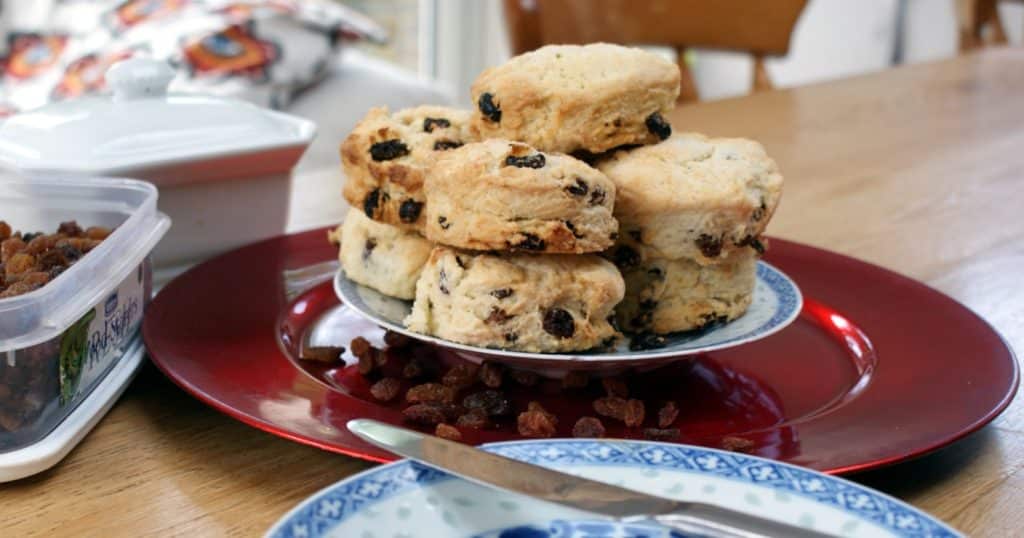
- Mix the flour and sugar.
- Stir in the raisins.
- Add the oil and water and mix to form a soft dough, being careful not to knead very much as this will toughen your scones
- Turn out onto the worktop and pat gently to a square shape about 2cm thick.
- At this point you can either cut the scones into lots of little ones, or fewer big ones. I like to use a 2.5″ / 6cm sized cutter.
We prefer the big ones. I like to cut the dough into 6 by cutting down the middle, then cut each side into 3 pieces, giving me 6 big scones. If you prefer to use a cutter, make sure you cut straight down without twisting as the twisting action compresses the edge of the dough and inhibits the scones from rising whilst baking.
- If you are making small ones, scoop all the scraps up after cutting out, squidge it together and cut out more, to use up all the dough
- Whichever you do, place your scones on a greased baking tray and bake in a hot oven for 12 minutes for diddy ones and 20 minutes for my huge ones. Brush them with milk (plant milk for vegans) and sprinkle sugar on top before baking for a crunchy finish
Too, too moreish warm from the oven
Can I make fruit scones with plain flour?
Well, yes, and no. You can certainly use plain (all purpose) flour, but you will need to add around 2 tsps of baking powder to each 250g flour or the scones won’t rise at all.
Variations
Add to the mix:-
- A tsp ginger, fresh, preserved or dried
- Or cinnamon, mixed spice or ground cloves
- Use any dried fruit you fancy, or how about date and walnut – yum
- Or make cheesey ones by leaving out the sugar and raisins and adding 100g grated strong cheese, a heaped tsp grainy mustard and grinding black pepper over the moistened top
- for a softer scone, replace the volume of some of the water with an egg and/or
- replace the water with any kind of milk
This is from Meal Plan 1, and also features in Meal Plan 2, Meal Plan 3, Meal Plan 7 and Meal Plan 8. All complete 7 day plans for 2 adults. Contain 3 meals a day, plus snacks , all recipes and a shopping list
Prefer Savoury Scones?
These tomato scones are very easy to make and have proven to be a popular recipe
Or these Rosemary, Mustard and Cayenne scones were super good, although the same can’t be said for the post!
Ingredients
- 270 g self raising flour or plain flour, with 2 tsps baking powder
- 50 g sugar
- 100 ml vegetable oil
- 100 ml water
- 120 g raisins
- 40 g butter or spread, to serve
Instructions
- Mix the flour and sugar.
- Stir in the raisins.
- Add the oil and water and mix gently to form a soft dough. Do not over-work as this will toughen your scones
- Turn out onto the worktop and pat gently to a square shape about 2cm
thick. At this point you can either cut the scones into lots of little
ones, or fewer big ones. - We prefer the big ones. I like to cut the dough into 6 by cutting down
the middle, then cut each side into 3 pieces, giving me 6 big scones. - If you are making small ones, scoop all the scraps up after cutting
out, squidge it together and cut out more, to use up all the dough - Or use a scone cutter. I used a 2½" / 6cm sized scone cutter. Cut straight down, without twisting as that will inhibit the rise of the scones whilst baking
- Whichever you do, place your scones on a greased baking tray and bake at
220C/200C fan/gas 7 for 12 minutes for diddy ones and 20 minutes for my
huge ones. Brush them with milk and sprinkle sugar on top before baking
for a crunchy finish - Scones, like most home baking is best straight from the oven. Any not eaten the same day of baking are best stored in the freezer, they go stale quickly
Equipment Needed
Notes
- A tsp ginger, fresh, preserved or dried
- Or cinnamon, mixed spice or ground cloves
- Use any dried fruit you fancy, or how about date and walnut – yum
- Or make cheesey ones by leaving out the sugar and raisins and adding 100g grated strong cheese, a heaped tsp grainy mustard and grinding black pepper over the moistened top
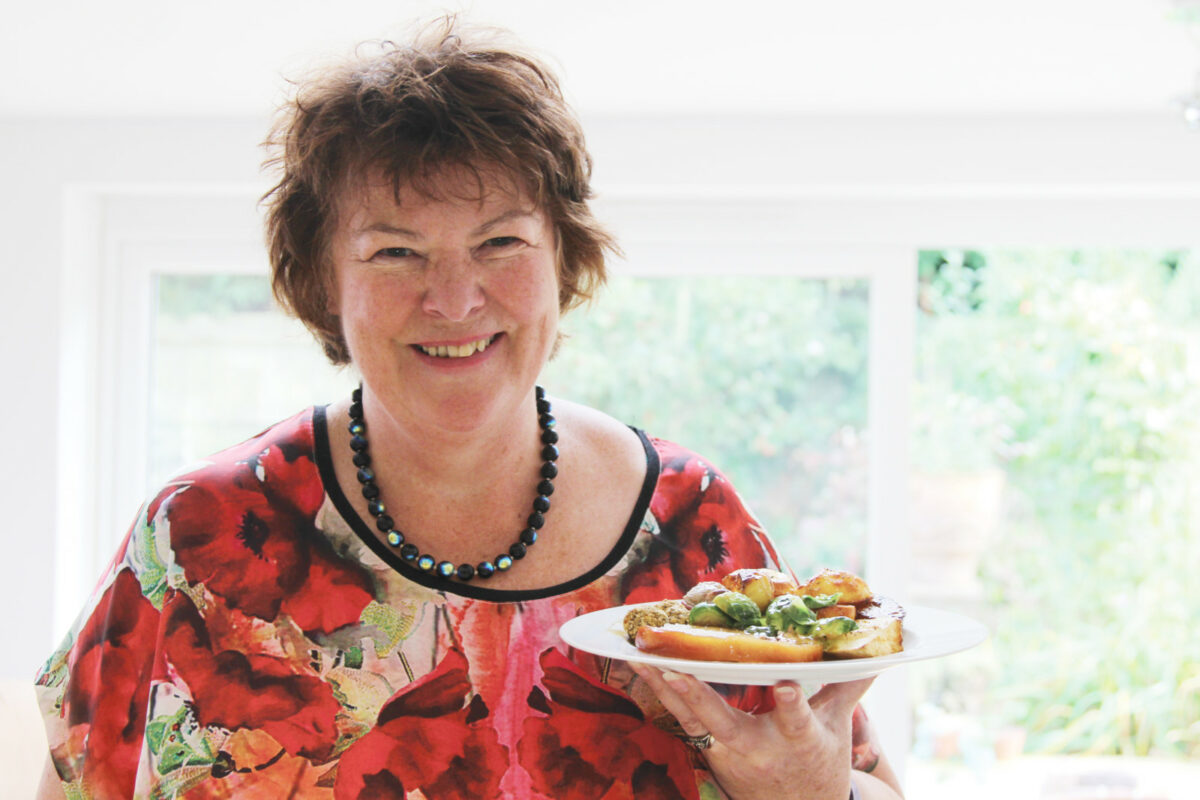
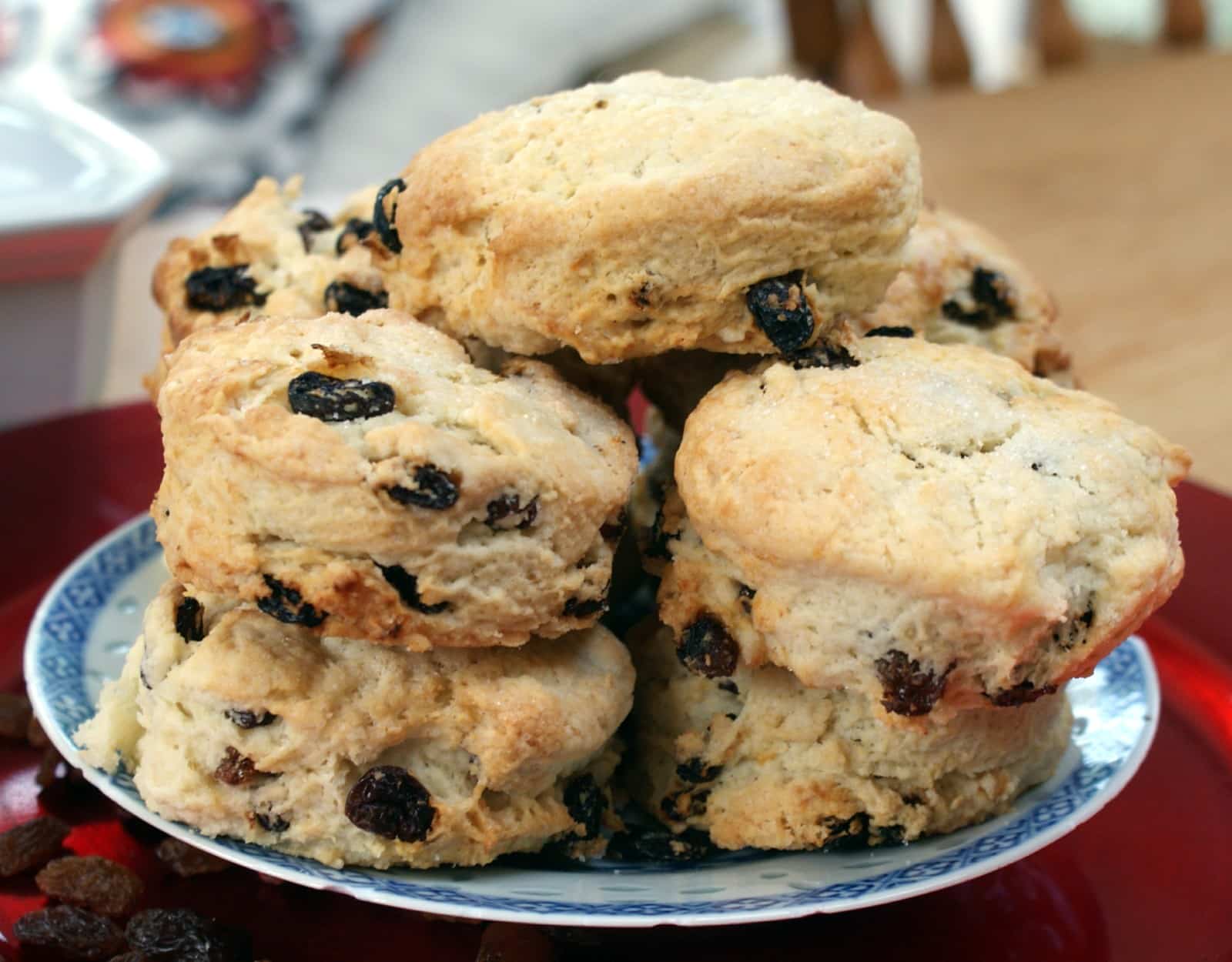




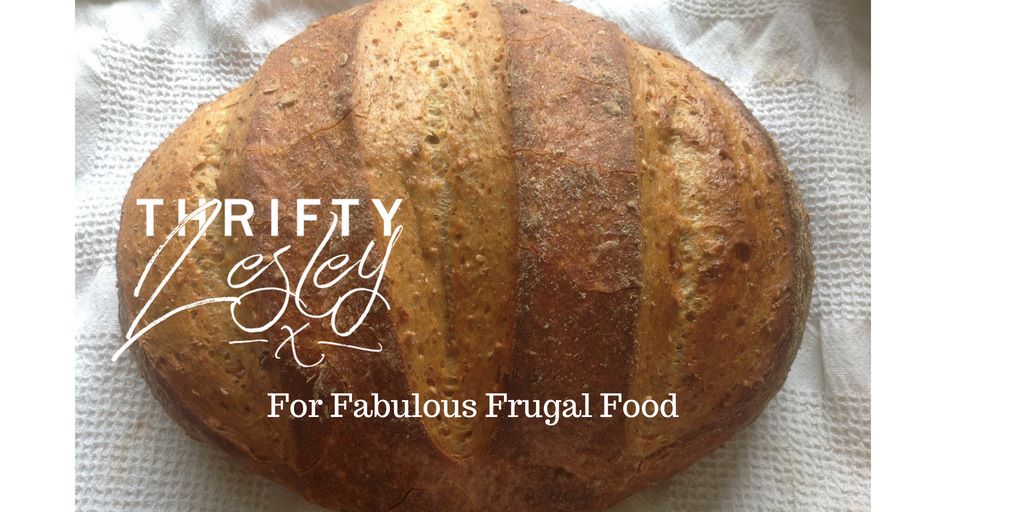

Glad they turned out well. They’re best eaten fresh, so if you’re keeping them for the week, maybe freeze them now and take a couple out each day for the days you are having them.
And yes, lovely with cream. And jam.
Following meal plan 1 & so I made 12 fruit scones yesterday for the week. I’ve allocated us 1 each per day except Sunday as we’ve got pudding that day
We’ve just had our first fruit scone & it was so yummy! My fiancé isn’t usually keen on anything with raisins or sultanas but he loved them & said they’d be great with cream might have to get some cream as a treat next time I make them